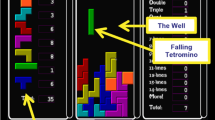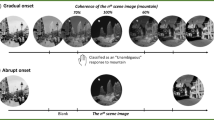Abstract
Previous research on cognitive deficits during shallow water immersion led to inconsistent results: some authors observed deficits at 5 m, but others only at depths well beyond 5 m. The present study evaluates whether this discrepancy could be related to different levels of difficulty. Forty-eight subjects participated in a mental rotation task and in a color-word task, both having multiple levels of difficulty. The two tasks were administered once 5 m below the water’s surface and once on dry land. Compared to land, subjects’ reaction time increased in 5 m depth when task difficulty was low, but it did not increase when task difficulty was high. Thus, performance deficits in 5 m depth were inversely related to task complexity. We interpret this counter-intuitive finding within the framework of a multiple-channel parallel processing model, with channels that are differentially sensitive to immersion. This model correctly predicts performance deficits on simple, but not on complex skills at smaller depths, and deficits on simple as well as complex skills at larger depths, in accordance with the present findings and data from literature.




Similar content being viewed by others
Notes
The rationale for using different body postures was that one of our cognitive tasks, mental rotation, might be affected by subjects’ body posture.
References
Bock O, Beurskens R (2011) Age-related deficits of dual-task walking: the role of foot vision. Gait Posture 33:190–194
Bolender H, Stevenin H, Bessone L, Torres A (2006) Preparing for space. EVA training at the European Astronaut Centre. ESA Bull 128:32–40
Cohen JD, Dunbar K, McClelland JL (1990) On the control of automatic processes: a parallel distributed processing account of the Stroop effect. Psychol Rev 97:332–361
Cohen JD, Servan-Schreiber D, McClelland JL (1992) A parallel distributed processing approach to automaticity. Am J Psychol 105:239–269
Dalecki M, Bock O (2013) Changed joint position sense and muscle activity in simulated weightlessness by water immersion. Aviat Space Environ Med 84(2):110–115
Dalecki M, Dräger T, Mierau A, Bock O (2012a) Production of finely graded forces in humans: effects of simulated weightlessness by water immersion. Exp Brain Res 8:790–795
Dalecki M, Hoffmann U, Bock O (2012b) Mental rotation of letters, body parts and complex scenes: separate or common mechanisms? Hum Mov Sci 31:1151–1160
Dalecki M, Schulze B, Bock O (2012c) Cognitive impairment during 5 m water immersion. J Appl Physiol 113:1075–1081
Dalecki M, Dern S, Steinberg F (2013) Mental rotation of a letter, hand and complex scene in microgravity. Neurosci Lett 533:55–59
Hancock PA, Milner E (1982) Mental and psychomotor task performance in an open ocean underwater environment. Res Q Exerc Sport 53(Pt3):247–251
Jarchow T, Mast FW (1999) The effect of water immersion on postural and visual orientation. Aviat Space Environ Med 70(Pt9):879–886
Kahnemann D (1973) In: attention and effort. Prentice-Hall Inc., Englewood Cliffs
McClelland JL, Rumelhart DE (1986) Parallel distributed processing, vol II. MIT Press, Cambridge, MA
Mears JD, Cleary PJ (1980) Anxiety as a factor in under water performance. Ergonomics 23(Pt6):549–557
Ross HE (1970) Adaption of divers to curvature distortion under water. Ergonomics 13(Pt4):489–499
Schneider W, Chein JM (2003) Controlled and automatic processing: behavior, theory, and biological mechanisms. Cogn Sci 27(Pt3):525–559
Steyer R, Schwenkmezger P, Notz P, Eid M (1997) Der Mehrdimensionale Befindlichkeitsbogen (MDBF). Hogrefe, Handeinweisung. Göttingen
Zhang H (1999) A parallel distributed processing model of stimulus–stimulus and stimulus-response compatibility. Cogn Psychol 38:386–432
Acknowledgments
The authors wish to thank Dr. T. Dräger, Dr. S. Guardiera and Dr. A. Mierau for their support in developing a precursor version of our setup. We also would like to thank S. Dern, N. Elting, T. Horel, R. Redder, S. Scherhag and B. Schulze for their help in data acquisition, L. Geisen, T. Kesnerus and M. Drescher for software development, and M. Küsel, J. Geiermann, and H. Schink for technical support. Our work was supported by the German Aerospace Center (DLR) on the behalf of the German Ministry for Research and Technology (grant 50WB0726). Responsibility for the contents rests with the authors.
Author information
Authors and Affiliations
Corresponding author
Rights and permissions
About this article
Cite this article
Dalecki, M., Bock, O. & Hoffmann, U. Inverse relationship between task complexity and performance deficit in 5 m water immersion. Exp Brain Res 227, 243–248 (2013). https://doi.org/10.1007/s00221-013-3506-4
Received:
Accepted:
Published:
Issue Date:
DOI: https://doi.org/10.1007/s00221-013-3506-4




